
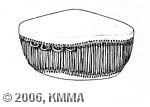
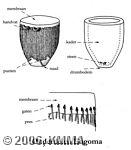
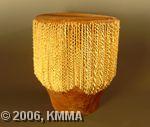
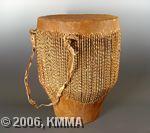

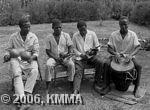
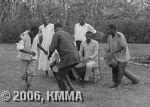



This single-skin drum is commonly used by the Bantu in the District of Ankole. It has a conico-cylindrical shape, but some royal drums are exclusively conically shaped. Conico-cylindrical means that the upper part of the body of the instrument is vertical, whereas the lower half has a cone-like shape. The diameter of the drumhead is therefore considerably bigger than that of the drumbase. The engoma is called a single-headed drum, in the sense that only the skin on the top of the instrument is used for beating. The second skin at its base is not for playing but forms a part of the lacing device. Traditionally the drum is made of wood, a piece of trunk in one piece selected from trees of a wide range of kinds. The engoma is carved such way that interior surface corresponds with the exterior, and that the average thickness of the sides about 2 cm is. Some carve the wood shortly after it's been cut, others prefer to work with dried wood. To prevent the wood from splitting it's is buried in the earth for a week after carving. Neither the drumhead nor the non-sonorous skin of the engoma is ever made of the skin of water animals, but always of hunted prey or cattle. Only the hides of old animals are suitable for membranes and thongs, because the skin of young animals is easily thorn. The thongs are strips - cut from the same skin as the membrane - to string the two membranes together. All the thongs are tied together by knots and may measure more than 60 metres. The thongs run over 300 times vertically up and down tying the membranes together by small made holes at the edge of the membranes. By fastening the membrane no particular lacing-pattern is followed. Skilled instrument-makers can completely hide the wooden frame of the drum by the thongs. Each engoma normally has two horizontal loops made of a bundle of skin-strips. The hollow body of the engoma always contains a little rattling object, usually it is a knotted piece of thong sometimes a pebble. It vibrates when the drum is played and thus improves the sound. This tiny part of the instrument is such an important one that it is called the 'soul of the drum'. Before playing, the instrument is put into the sun, or close to the heat of a fire so the membrane shrinks a little bit of dryness, the sound gets higher and better.
Normally the engoma stands erect in front of the drummer who squats or kneels on the ground. The small, thin drumsticks of equal thickness are straight, never curved or hooked. The rim of the drum is never struck by the drumsticks.
The Iru, the Kiga and the Hororo usually play the engoma with one drumstick, whereas the Kooki, the Nyambo and the Kunta play with two sticks or with their hands. The engoma does not exist at all in Hima society.
Except for some royal music, the engoma is never played solo but accompanies singing and other instruments. Nowadays they are also played together with the endingidi-music.
Throughout the district the engoma is beaten by men as well as woman, but in royal enclosures they are only played by men.
for more information see also: VAN THIEL, Paul, "Multi-Tribal Music of Ankole. An ethnomusicological study including a glossary of musical terms." Edited by the Royal Museum for Central Africa, Annales, Sciences Humaines, nr 91, 1977, 234 pp.
© KMMA/Paul VAN THIEL